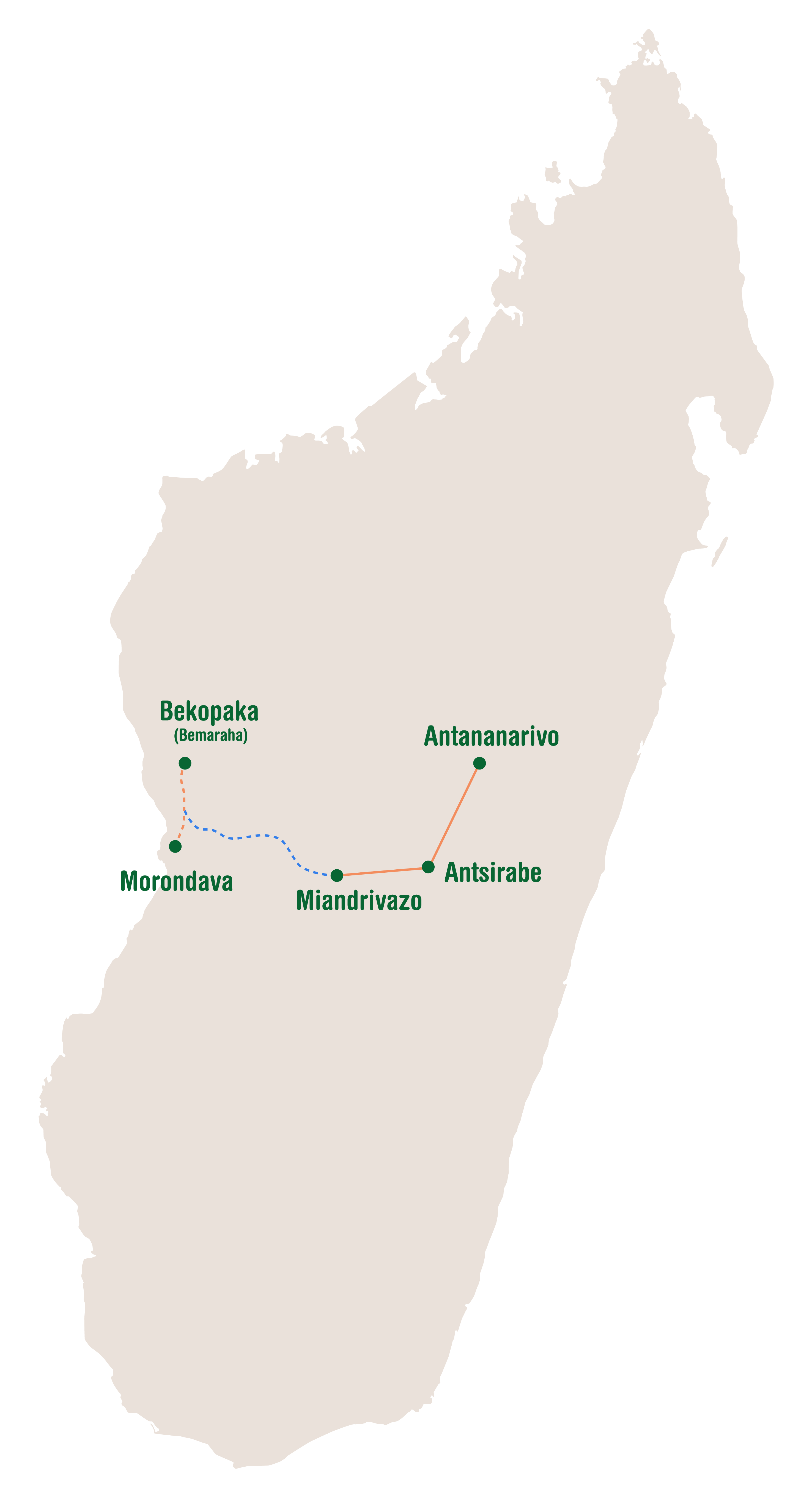Request for TOUR OPERATOR CATALOG SEASONAL RATES at: booking-quote@madagascar-explorer.net
When you get to Miandrivazo, driving on a nice paved road crossing the western Highlands, you take the inland trails as far as the shores of the Mahajilo (a tributary of the Tsiribihina). This is where the river navigation starts. You travel in covered motor boats; the largest ones have a kitchenette and a sun-deck. After another tributary joins it, the majestic Tsiribihina flows between the spurs of the Highlands and then enters the high vertical walls of the Bemaraha Canyons where the tropical forest grows and the lemurs live. During the stops you penetrate the inner territory to see fantastic waterfalls and natural pools in the luxuriant vegetation. After this the river flows through the savannah, dotted by baobabs, among mango and tamarind forests, and the farms and villages of the Sakalava people. During the 2 days navigation you can see parrots, ducks, herons and pink ibis, and sometimes crocodiles and turtles on the rocks and lemurs in the trees. Overnight you sleep on the riverbank in igloo tents with mosquito netting curtains. You have your meals on board or you go ashore, depending on the number of participants. After landing you go by car (off-road vehicle) along the trail which crosses the tropical forest to Bekopaka/Tsingy of Bemaraha National Park in about 4 hrs.
The spectacular mineral forest of Tsingy de Bemarahastands on the western coast of Madagascar. Tsingy is the Malagasy word for “walking on tiptoes” and the nearly impenetrable labyrinth of limestone needles justifies this name. The whole protected area, designated a World Heritage Site by the UNESCO in 1990, comprises a surface of 1.575 km². This remote area was not a tourist trek until 1998, when the southern part (723 km²) was declared a National Park. The northern section is an Integral Reserve so tourists are not allowed to enter the zone. The reserve’s canyons, gorges, undisturbed forests, lakes and mangrove swamps display an astonishing richness of fauna and flora which have not been completely recorded. The rate of endemism is about 85%, and 47% are even local endemic!
The limestone seabed rose to create a plateau around 200 million years ago, which was little by little eroded by heavy rainfalls until it became its actual shape. This massif is delimited to the east by the abrupt Bemaraha Cliffs, which rises some 300 to 400m above the Manambolo River valley and extends several tens of kilometres from north to south. The western slopes of the massif rise more gently, and the whole western region of the reserve forms a plateau with rounded hillocks which slope away to the west. To the north undulating hills alternate with limestone extrusions, while in the south extensive pinnacle formations make access extremely restricted. In the south of Petit Tsingy is the spectacular Manambolo Gorge where you can see waterfalls, lemurs and magnificent untouched forests. Despite the inaccessibility of the area, this park is more and more part of tour operator programs.
The flora has a high local endemism rate. The western part is principally covered by deciduous dry forests, which are particularly well adapted to the extreme changing climate conditions of the area. The eastern section is formed by grassy savannas and lowland bushes. Inside the canyons we find small areas of dense tropical forests and lianas, since it is very humid among the tall tsingy formations.
Visitors can spot 11 lemur species, including for Decken’s sifaka, red-fronted brown lemur, fat-tailed dwarf lemur, grey mouse lemur or the Cleese’s woolly lemur and the Sambirano lesser bamboo lemur, which only occur here. Other resident mammals are the small carnivorous falanouc and ring-tailed mongoose, and several bats.
More than 100 bird species have been catalogued at present inside the National Park, including the critically endangered Madagascar fish eagle and crested ibis, Madagascar wood-rail, giant coua or Coquerel´s coua.
The 45 reptiles and amphibians which are found here are all endemic. Some significant species which only occur in Bemaraha are the Madagascar iguana, a local endemic long-tailed skink and the Antsingy leaf chameleon.
Generally most visitors coming to the park usually stay over three nights to explore this unique and amazing place. A recommended plan would be:
Day 1: Petit tsingy: this circuit of 4-5 hours of duration passes through a labyrinth of limestones and two view points over the impressive pinnacles. There are some good chances to spot the Decken’s sifaka and red-fronted brown lemurs. Manambolo gorge: It is a canoe trip along the gorge combined with an easier path through caves, stalactites, stalagmites and the famous family tomb of the Vazimba tribe.
Day 2: The big Tsingy: This is probably the most rewarding whole-day trip within the park as it goes deep into the limestone forest passing through several hanging bridges with the impressive karstic formations below your feet. The trail is not technically difficult and even children can cope with it, but you certainly should not suffer from vertigo! The look down from the hanging bridge is something to avoid for the easily fainted.
Antananarivo(Google Map)
When you get to Miandrivazo, driving on a nice paved road crossing the western Highlands, you take the inland trails as far as the shores of the Mahajilo (a tributary of the Tsiribihina). This is where the river navigation starts.
Departure by car from Antananarivo along the road that crosses the central Plateau, characterised by villages of houses built with red dirt, and large stretches of cultivated rice fields. After about 3 hours arrival at Antsirabe, which is a typical town on the highlands, lined with swarms of brightly coloured posy (rickshaws). After lunch, continue itinerary west, crossing a region which is densely cultivated by the local Vakinankaratra population, then towards vast regions of bare hills and savannahs as far as the eye can see, which are crossed by herds of pasturing zebus. Then arrive near Miandrivazo, one of the hottest towns in Madagascar. Dinner et overnight at Princesse Tsiribihina Lakana hotel (standard room) or similar.
After breakfast continue towards the banks of the Mahajilo river, tributary of the Tsiribihina. Boarding and begin navigation through the tree-filled savannahs to the first campsite, which is reached late afternoon. Set up of camp by the staff, on the banks of the river, near a Sakalava village. Meals on board and overnight stay in tents.
Breakfast at the campsite, then continue navigation, during which you can see various bird species along the banks of the river, like various coloured herons, the strange-looking drongo with its typical plume, various species of predators like, at times, the fishing eagle. Stop along the way on the river to walk to a beautiful waterfall which originates at a “natural swimming pool” where you can swim in the clear waters, sometimes observed by shy lemurs… Continue navigation, the current becomes faster when the river enters gorges, characterised by high vertical walls and verdant vegetation and the habitat for families of lemurs. Arrive at second campsite at the end of the day. Meals on board and overnight stay in tents.
Breakfast at the campsite, then continue navigation along the savannah where the first baobabs appear and the Sakalava villages, on the river banks, increase in number. Lunch on board before the end of the navigation, then disembark and continue by car along the track that leads to Bekopaka/Tsingy of Bemaraha National Park; proceed along the track which crosses the shrubby bush, where you can see, amongst other things, the funeral constructions of the Sakalava people, painted in bright colors; then you ford again along the Manambolo river, then you reach your hotel L’Olympe de Bemaraha (standard room) or similar; picnic lunch during the way; in the evening, dinner and overnight stay at the hotel.
In the morning visit the Petits Tsingy, calcareous rock formations which are in the surrounding savannah which form an almost impenetrable barrier and which has preserved this primitive environment intact; then you explore the tropical forest inhabitated by Sifaka lemurs and late afternoon relaxing sailing along the short route of the Manambolo river, until the beautiful Gorges, covered with luxuriant vegetation; return to hotel at the end of the day; meals and overnight stay in hotel L’Olympe de Bamaraha (standard room) or similar.
Whole day devoted to visiting the fantastic big Tsingy; a walk along the savannah leads us to the base of the rocky walls, which is an ancient coral reef, carved in spires – which can reach a height of 60 meters from the ground – by the atmospheric conditions, over hundreds of millions of years; exploration of UNESCO World Heritage listed places; picnic lunch during the excursion; return to hotel at the end of the day; dinner and overnight stay in hotel L’Olympe de Bemaraha (standard room) or similar.
After breakfast, return towards Morondava, meeting fascinating natural wonders along the way; stop for sunset in the Baobab savannah; lunch in restaurant during the trip; dinner and overnight stay in hotel Palissandre Cote Ouest Resort (standard room) or similar.
Breakfast in hotel; according to the time at disposal, transfer to the airport.

